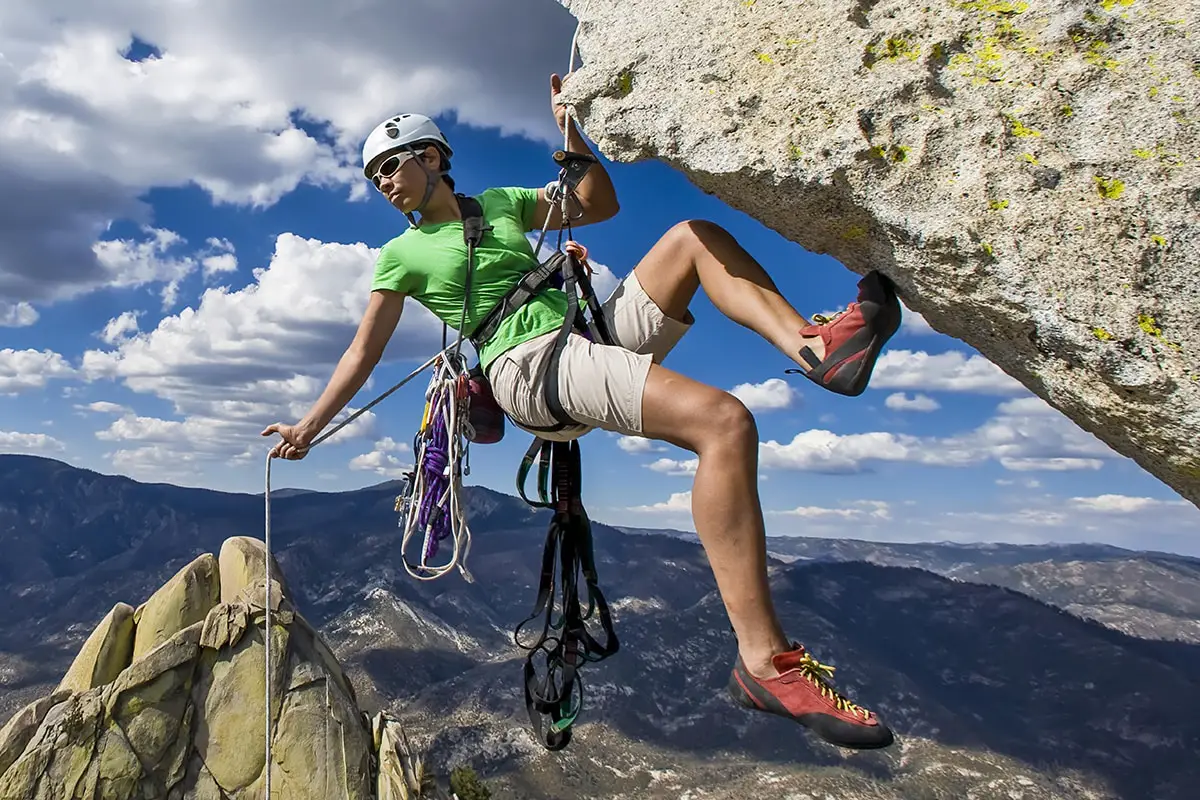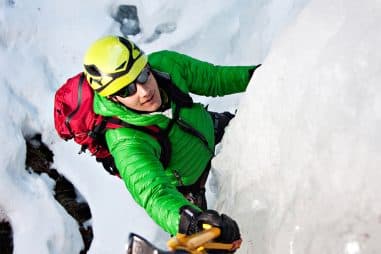If you are a beginner, do not rappel on your own unless you are being guided by an expert. Rappelling is when most climbing accidents happen so taking the time to learn how to rappel properly is crucial. Signing up for classes by certified instructors and being taught by experienced climbers is the surest way to become skilled at rappelling.
What is Rappelling?
Rappelling is a technique used by mountaineers and climbers when going down cliffs or slopes that are too steep and dangerous to descend without some form of support. Rappelling uses friction to slow down the rate of descent. This is done by using a rope wrapped around the body to control the descent or some other friction-type device to limit your descent speed.
In the single-rope style of rappelling, you rappel on a single-strand of rope while you rappel on two strands of rope for the double-rope style. The single rope style is usually used when you may want to reclimb the line later while in using the double strand rope, you can retrieve the rope by pulling on one end so the rope can be detached from the anchor at the top.
How Do You Rappel?
Rappelling is done by threading a rope you use for descending through a braking device or mechanism attached to your harness. The most versatile rappelling device should have two slots so you can use them to rappel off either one or two ropes. Whether you are using a single- or double rope rappel, the basics are the same. We will discuss only double-rappelling in this article since the technique is the same.
The following steps may be followed when you are going to rappel:
- The first step is to secure yourself to an anchor before attaching the rappelling rope to yourself.
- Make sure the rappelling rope reaches or even extends beyond the ground or your next rappel station. You may join two lengths of ropes together using the double fisherman’s knot if one length of rope is not long enough.
- Prepare the rappelling rope by threading it through the anchor and have the midpoint of the rope positioned in the anchor. You may a climbing rope made of two different colors. This will make it easy to identify the middle of the rope.
- As a precaution, immediately tie a figure-of-eight knot at the ends of the rope. The knots will serve as a stopper so you don’t rappel off the end of the rope, one of the most common accidents in rappelling. Be sure to leave more than 100 mm “tail” below the knots.
- Once your rope is ready, thread it through the braking device and attach it to the belay/rappel loop of your harness. Use a large locking carabiner to connect your device to the harness. Your belay/rappel loop is specially designed to keep the braking device in its proper orientation.
- Connect a backup prusik on the rope below your rappel device and connect it to your leg loop on the same side as your brake hand. This backup prusik will lock onto the rope in the event that you lose control of the device and prevent uncontrolled descent.
Before rappelling, double check everything:
- The rope is properly threaded to the anchor and your rappel device.
- The rope is of sufficient length so it reaches the ground or your next rappel station.
- The rope has safety knots tied on its ends.
- The rappel device is properly attached to your harness and locked with a locking carabiner.
- If everything is secure, you may now unclip yourself from the anchor. Test the anchor by putting your full weight on it before descending.
Is Rappelling Easy?
Rappelling may seem easy but it is not easy nor simple. The fact is you must be well-trained to rappel safely. It is imperative that you get professional training and advice when learning to rappel. Most gyms offer this service to climbers.
Before you can rappel, you must master several kinds of knots and learn to use your equipment properly. This makes sure that you are familiar with your equipment and its functions before using them. Then you must learn the techniques of rappelling, how to efficiently use your body, arms, and legs while descending.
Is Rappelling Scary?
Rappelling should not be scary if you are well-prepared for the experience. This is why you must take rappelling lessons before attempting it. Once you have mastered the rappelling technique, it’s a matter of overcoming the mental hurdle of trusting yourself and your equipment.
You will be more mentally prepared to rappel if you have properly trained, familiarized yourself with your equipment, double- and triple-checked your setup, and discussed the descent with your partners. When all of the gear and planning have been suitably prepared, rappelling can be an enjoyable part of the climb.
Is Rappelling Dangerous?
Rappelling is actually one of the most dangerous parts of climbing. Statistics collected by climbing organizations show that about 25% of climbing accidents happen during rappelling. However, these common causes of rappelling accidents can be avoided by following a few simple rules.
The number one cause is anchors failing during the rappel. This can be avoided by making sure the anchors are secure and tested before committing yourself to it. If in doubt, replace it or find a more suitable location for the anchors. Complacency, in the form of not having adequate safety backups, is also a major cause of accidents. Rappelling off the ends of the ropes comes in as the third most common cause of mishaps.
Why is Rappelling So Dangerous?
Rappelling is so dangerous since the activity has so many things that can go wrong. You need the proper rappelling equipment and you must learn to use it properly. The equipment has to be well-maintained or replaced as soon as it shows signs of wear and tear. The following are just some of the things that could go wrong.
- The anchors could fail.
- The knots could become undone.
- You forget to tie the ends of the ropes.
- You forget to install your prusik back up.
- You might rig your rappel device improperly.
- Your rope might get caught in the cracks or cut by sharp edges.
- Your clothing might get caught in the rappel device.
Rappelling is also a shared exercise and a simple miscommunication could result in accidents. Be sure to communicate clearly with your companions when rappelling. As in other activities like swimming, rappelling should be done using the buddy system. Have your buddy double-check your gear and do the same for him.
What is Rappelling in Rock Climbing?
Rappelling is used in rock climbing as a way to descend after the climb. Rock climbing is the sport of climbing rock formation with or without the help of ropes using your own strength. As in other climbing sports, rock climbers use rappelling to descend if the slope is too steep to descend without the aid of ropes.
Rock climbers use a variety of techniques and equipment to scale the mountain or cliffs. They can use harnesses, ropes, slings, anchors, etc. to aid them in climbing. Or they can free solo, that is, climb without any artificial aids such as ropes and other equipment. Whatever the technique used for the climb, rappelling always uses an assembly of ropes and other hardware when descending.
What is Rappelling in Mountaineering?
Mountaineering is the climbing sport of identifying a specific mountain and route to climb. The climb is executed by the use of climbing aids as well as incorporating the elements of free climbing. Ascending a mountain summit is the ultimate goal of the climb whether it is with or without equipment.
Again, rappelling is used to facilitate the descent when the route cannot be navigated unaided. As always, rappelling is a necessary skill in mountaineering.
What is the Difference Between Belaying and Rappelling?
The main difference between belaying and rappelling is in belaying you are being lowered by your companion while you are lowering yourself down by rappelling. Belaying is also used in the ascent whereas rappelling is mainly used for descending. In using the belay for the ascent, your companion takes hold of the other end of the rope while the other end is connected to you. Your companion, the belayer, maintains sufficient tension or slack on the rope to prevent you from falling a long distance should an anchor be dislodged from its setting.
The belaying rope can also be used as the rappelling rope. However, some climbers prefer to use a “dynamic” rope for belaying as it has some stretch to it. The climber will not come to a sudden jerking stop if he falls. The static rope is preferred for rappelling as it is much easier to use for this purpose.
Is Rappelling a Sport?
Strictly speaking, rappelling is not a sport. It is considered a part of climbing sports where its role is to aid in the descent after the climb.
Some rappelling aficionados however consider it as a sporting activity in itself. There is waterfall rappelling which the name suggests you rappel down a waterfall. It is also known as canyoning in rappelling circles. There is also cave rappelling where you rappel down the mouth of a cave to its bottom.
How Do You Practice Rappelling?
The most important thing to do when learning to rappel is to have someone who can teach you how to rappel safely. Having a professional climber teach you the fundamentals of rappelling will go a long way in keeping you safe and in building competence. After learning the basics correctly, you can then sharpen those skills on your own.
How to practice rappelling then? Practice in an environment where mistakes can be made without the dire outcomes of those slipups. Removing the consequences of those mistakes will allow you to concentrate on learning the correct techniques instead of getting distracted by the dangers. Practicing in a controlled setting and getting advice from your instructors can enhance your rappelling skills without putting yourself in needless danger.
How Do You Rappel Alone?
Even if you are an expert, it is never recommended that you rappel alone. The activity is dangerous enough as it is to put yourself in extra danger. Too many things could go wrong, unexpected weather, natural phenomena, rock slides, equipment malfunction, etc.
This activity is safest done with at least one companion or better yet with several companions. As mentioned earlier, the buddy system should be employed in this activity for the best experience. This is a thrill worth sharing with a friend.
What is Simul Rappelling?
Simul rappelling is when two climbers use the same rope to descend at the same time. This is an advanced technique that only experts should attempt. This type of rappelling should only be used in extreme situations and when individual rappelling is not possible since this is more dangerous than conventional rappelling.
Simul rappelling is done by two climbers descending on the same rope at the same time. This scenario might be employed should the need to retreat from an oncoming weather disturbance not permit enough time for a normal descent. In some cases, there might not be a safe anchor point so a simul descent is necessary. Below are some do’s and don’ts when simul rappelling.
Do’s:
- Do weight and unweight the rope at the same time. Without counterbalancing, one partner may fall and pull the rope with him, leaving the other without any support and he may fall at the same time.
- Do be mindful of your weight difference if a bit substantial. The heavier partner may descend faster due to being heavier and may pull up the other one so be aware of your weight difference. The heavier one should rappel below the lighter partner. You must be connected to each other by a double-length sling.
- Do communicate. You have to rappel at the same speed to maintain your distance from each other. Stay 5 meters apart at most to better communicate clearly and frequently.
- Do tie the ends of the rope. If one rappels of the rope, the other will fall as his weight has no more counterbalance.
- Do have a backup. In case one loses control, the other will have no counterbalance and the consequences are unthinkable.
Don’ts
- Don’t simul rappel if the terrain seems difficult. For example, the ground might be loose and you wind up dislodging rocks onto your partner below.
- Don’t rely on webbing for anchors when simul rappelling. The added weight and constant movement of the rope will cut through the webbing prematurely and cause it to fail. Make sure the anchor can hold both of your weights.
What is Waterfall Rappelling?
As the name suggests, waterfall rappelling is done by rappelling in waterfalls! The idea is easy enough to grasp and practice; get into a harness and rappelling rope and lower yourself down a waterfall or have someone belay you down.
If you are a beginner, there are a few tours offering this type of adventure. They provide all the equipment and some basic safety and training briefing before getting you down the waterfalls.
Is Waterfall Rappelling Safe?
As long as you follow the standard procedures and practices, waterfall rappelling should be safe. A little extra safety consciousness may be necessary due to more slippery conditions and having the waterfall cascade over you. It should not be much different from a simple rappel. But it’s a lot more fun!
Of course, the added factors of cold water and slippery terrain affect the whole experience making it a more challenging but very fun version of normal rappelling.
How Do You Rappel Down a Waterfall?
You rappel down a waterfall in much the same way as you rappel down from a mountain. You can have someone belay you down or you can rappel yourself down. You use the same equipment and use the same technique.
Gear-wise, a static rope is recommended as it helps with grip and rope control when you and your hands are soaked in water.
What Do You Wear to a Waterfall Rappelling?
A few simple clothing rules to follow when waterfall rappelling is wearing quick-dry clothing and using water-resistant footwear. Some tours provide the shoes to make sure they are activity-appropriate.
You must also take into account your rappelling location. Some countries’ weather is fairly hot and humid that you can do with just a shirt and shorts but other locations just might be too uncomfortably cold so a wetsuit is a must.
Can You Rappel Down El Capitan?
Rappelling down El Capitan is one way of getting down after scaling it. However, only the more proficient mountaineers can handle rappelling off El Capitan. The drop is vertical so only the most experienced are capable of rappelling down El Capitan.
This descent from El Cap is known as the East Ledges descent. It consists of a steep hike down followed by a vertical rappel. This is the fastest way of getting off El Capitan but also the most dangerous and complicated way.







